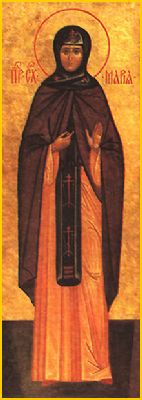|
|||
|---|---|---|---|
| This weekly bulletin insert complements the curriculum published by the Department of Christian Education of the Orthodox Church in America. This and many other Christian Education resources are available at http://dce.oca.org. | |||

The Church honors a saint who lived in the 14th century but who was glorified much more recently, in 1992. She is Maria, the mother of Saint Sergius of Radonezh. Her story gives insight into the effect on mothers when a child desires to become a monastic. Young Bartholomew (Saint Sergius' baptismal name) expressed this desire fairly early in life. But both his brothers were married and had families to take care of, so the parents were not eager to let him leave. He agreed to delay his departure in order to take care of them. This was especially important for Maria. Had her husband died, she would have had only her sons to depend on. In respecting his parents' wishes, Bartholomew was similar to Saint John Chrysostom, whose mother Anthusa had been widowed very young. When her son told her he wanted to be a monk, Anthusa pointed out that there were family lands to be managed, taxes to be paid, and wily officials eager to take advantage of an inexperienced and unworldly woman who had suddenly been thrust into great responsibility. Like Bartholomew, John put off his entry into the monastic life to help his mother. Though Maria needed her son, she was open to God's plan for him. In this she was like other holy mothers. Hannah, the mother of Samuel, dedicated her long-awaited only child to the Temple. Elizabeth, the mother of John the Baptist, paid attention when the child in her womb leaped for joy at the sound of the Virgin Mary's greeting, and called young Mary "the mother of my Lord." Maria and her husband lost no time in bringing their little Bartholomew to church and offering him as God's servant, believing this was His will for the child. Maria was fortunate in having raised children who loved and cared about each other. In this too she was like other mothers of saints. Gregory of Nyssa wrote with great admiration and gratitude about his sister Macrina. Many saints made sure their siblings were provided for before becoming monastics. Bartholomew did this, bequeathing his considerable possessions to a brother before entering the new life in which he would be tonsured with the name Sergius. 
Again like other mothers of saints, Maria made an agreement with her husband that they would go to separate monasteries. That is where they spent the remaining years of their lives. The title given to Maria by the Church is "Venerable Schema-Nun." That she became a schema-nun means that she reached a high spiritual level in the judgment of her superior, the abbess. She had already taken the formal vows of chastity, obedience, poverty and stability of place. She was already entitled to wear the mantle of a monastic. But as a schema-nun, she reached the highest level of monasticism. Saint Maria lived as a wife, a mother, and an advanced monastic, all in one lifetime. It's a richness befitting the woman who bore and raised one of Russia's greatest saints. |
|||
